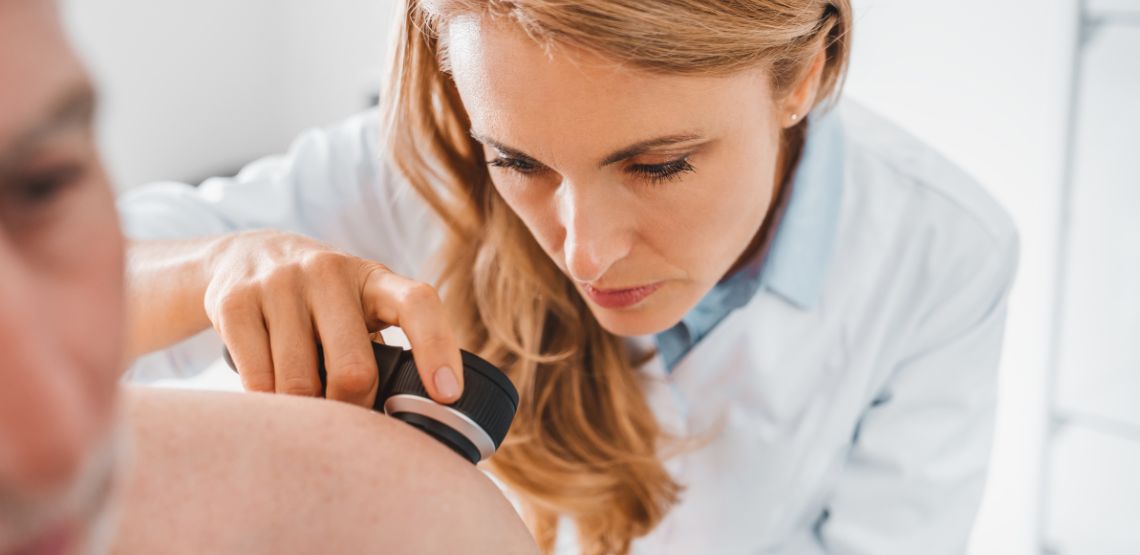Early Detection Matters
There is an importance to knowing the signs early on with skin cancer, to help ensure you can treat it effectively. In this article, we will explore the various signs of skin cancer, discuss the importance of early detection and provide information on foods and treatment options like Braftovi, a medication used in the treatment of certain types of cancer, like melanoma (a type of skin cancer). In melanoma, Braftovi is often used in combination with another medication called binimetinib (Mektovi) for patients with advanced melanoma that has a specific genetic mutation known as BRAF V600E or V600K mutation.
Signs of Skin Cancer
Basal Cell Carcinoma (BCC)
BCC typically appears as a pearly or waxy bump, often with visible blood vessels. It may also resemble a sore that does not heal or an elevated scar-like area. BCC tends to occur on skin that is frequently exposed to the sun, such as the face, neck and hands.
Related Search Topics (Ads)
Squamous Cell Carcinoma (SCC)
SCC commonly presents as a firm, red nodule or a flat sore with a scaly crust. It may bleed or develop into an open sore that fails to heal. SCC often occurs on sun-exposed areas, including the face, ears, neck, lips and back of the hands.
Melanoma
Melanoma is the most aggressive form of skin cancer and can develop from an existing mole or as a new mole. Warning signs include moles or growths that are asymmetrical, have irregular borders, exhibit multiple colors, have a larger diameter or evolve in size or appearance over time. Melanoma can occur anywhere on the body, including areas not exposed to the sun.
Skin cancer can manifest in various ways, and its symptoms can differ depending on the type of skin cancer. The three most common types of skin cancer are basal cell carcinoma (BCC), squamous cell carcinoma (SCC) and melanoma.
Early Detection: The Importance of Self-Examination
Regular self-examination is crucial in detecting skin cancer at its early stages. The American Academy of Dermatology recommends that individuals perform a monthly self-examination of their skin, paying close attention to any changes in moles, freckles or other skin growths. When examining your skin, remember the ABCDE rule.
- Asymmetry: One half of a mole or skin growth does not match the other half.
- Border: The edges of a mole or skin growth are irregular, blurred or jagged.
- Color: The color of a mole or skin growth is not uniform and may include shades of brown, black, pink, red or white.
- Diameter: The size of a mole or skin growth is larger than 6 millimeters (about the size of a pencil eraser).
- Evolving: A mole or skin growth that changes in size, shape or color over time.
Foods That May Aid in Prevention and Recovery
While a healthy diet cannot prevent or cure skin cancer, certain foods may provide beneficial nutrients that support overall skin health. Antioxidant-rich foods, such as fruits and vegetables, can help neutralize harmful free radicals that may contribute to skin damage. Include a variety of colorful produce in your diet, such as berries, citrus fruits, leafy greens and bell peppers.
Omega-3 fatty acids, found in fatty fish like salmon and mackerel, as well as flaxseeds and walnuts, have anti-inflammatory properties that may support skin health. Additionally, green tea, which is rich in polyphenols, has been studied for its potential protective effects against skin cancer.
It is important to note that while these foods may have potential benefits, they should not be considered as standalone treatments or substitutes for medical advice. Always consult with a healthcare professional regarding your specific dietary needs and potential interactions with any ongoing treatments.
Treatment Options for Skin Cancer
The treatment options for skin cancer depend on various factors, including the type and stage of cancer, as well as the patient's overall health. Here are the most common treatment methods.
Surgery: Surgical excision is often the primary treatment for skin cancer. It involves removing the cancerous tissue along with a surrounding margin of healthy skin.
Mohs surgery: This specialized surgical technique involves removing thin layers of skin and examining them under a microscope. It is commonly used for treating skin cancers on the face or areas where the preservation of healthy tissue is crucial.
Radiation therapy: High-energy X-rays are used to destroy cancer cells. Radiation therapy may be recommended as the primary treatment or in combination with surgery for certain cases.
Topical medications: Creams or gels containing medications such as imiquimod or fluorouracil may be prescribed for early-stage skin cancers or precancerous lesions.
Targeted therapy and immunotherapy: In advanced cases of melanoma, targeted therapy drugs or immunotherapy may be used to attack specific cancer cells or boost the body's immune system response.
BRAFTOVI: BRAFTOVI (encorafenib) is a medication approved for unresectable or metastatic melanoma with a BRAF V600E or V600K mutation, which is either inoperable or has metastasized to other areas of the body and cannot be surgically treated. It is often combined with other drug therapies.
Final Notes
Skin cancer is the most common form of cancer worldwide. While it can be a serious and potentially life-threatening condition, early detection is key to successful treatment and a positive prognosis.
Skin cancer is a serious condition that requires early detection for successful treatment. By familiarizing yourself with the signs and symptoms of skin cancer, performing regular self-examinations and seeking professional evaluation when needed, you can take an active role in your skin health.
If you suspect any signs of skin cancer or have concerns about your skin, consult a dermatologist for an accurate diagnosis and appropriate treatment options. Your skin deserves the utmost care and attention to promote a healthy and cancer-free future.

